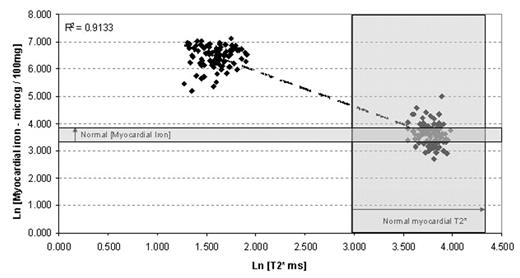Abstract
Introduction:. Myocardial iron can now be rapidly and reproducibly assessed using a validated cardiovascular magnetic resonance (CMR) T2* technique. However, the calibration of T2* value to absolute myocardial iron concentration is currently unknown in humans.
Purpose: To calibrate myocardial T2* values in post-mortem hearts.
Methods: Two patients’ hearts have been examined. Each was scanned at 37 Celsius using optimised T2* MR sequences. Iron assays were performed with 100 samples per heart, from 5 short axis slices of the left ventricle. For each slice, 6 segments were cut and a sample taken from the endocardium, mid-wall and epicardium, and 2 from the right ventricular free wall (20 samples per slice). This trial was supported by NIH grant R01 DK66084-01.
Results: Heart 1 from Genova Italy, was from a patient with beta-thalassemia major who had been transfused from age 2 to his death at age 47 from a stroke. The patient had heart failure aged 21 years, from which he had recovered. At age 46, the patient had bradycardia and arrhythmia, and his long-term deferoxamine treatment was augmented with deferiprone for 6 months, and then switched to deferiprone alone at 69mg/kg/day for 7 days per week, starting 1 year prior to death. Ex vivo mid-ventricle full thickness septum T2* was 45ms.
Heart 2 from London was from a transfusion dependent patient with sideroblastic anemia with poor compliance with deferoxamine. The patient died in heart failure. Further clinical details are awaited. Pre-mortem mid-ventricle septum T2* was 5.2ms, and the T2* value in the same region post-mortem was identical at 5.2ms. The results of the ex-vivo comparison of segmental myocardial T2* and matching segmental absolute iron level are shown in figure 1. Calibration is shown on a log-log scale in accord with previous liver sample evidence showing this allows fitting with a linear function (
Conclusion: These are the first human data calibrating human myocardial T2* against absolute iron levels. Myocardial T2* clearly decreases as myocardial iron increases. Of interest was the identical myocardial T2* result between the in-vivo and post-mortem scans in patient 2. Further hearts are now needed to complete the calibration and to determine the consistency of calibration between hearts.
Author notes
Corresponding author


